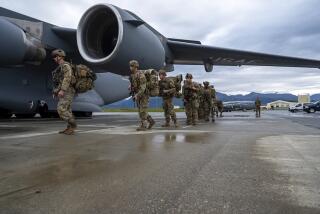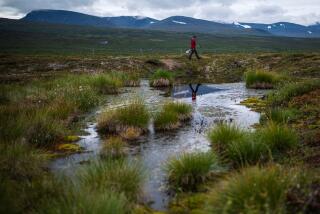Coast Guard beefs up deployment in the U.S. Arctic
With increasing ship traffic through once-frozen northern seas and the expected debut of offshore oil drilling as early as July, the U.S. Coast Guard is launching Arctic Shield, its largest-ever deployment in the Arctic Ocean.
Coast Guard officials disclosed this week that they will be mounting full-scale Coast Guard cutter patrols as well as helicopter and small-craft operations across the northern and western coasts of Alaska as Royal Dutch Shell prepares to drill exploratory wells in the Chukchi and Beaufort seas.
“As the ice has receded and there’s more open water, we’re moving our operations up north,” Capt. Adam Shaw, chief of prevention for the Coast Guard’s 17th District in Alaska, said in an interview.
“It’s not just Shell’s activities; there’s the presence of other activities up on the North Slope and the Bering Strait, and that’s what’s driving our operations this summer,” he said.
Warming global temperatures have had a dramatic effect on the amount of shipping traffic in the far north, as routes through the fabled Northwest Passage above Canada and across the top of Russia have begun to open. Polar tourism, oil and mining operations, and commercial shipping are now all present in a region that once was home mainly to small whaling boats and delivery barges.
Within a few years, commercial fishing — presently the subject of a moratorium in U.S. Arctic waters — could move north from the Bering Sea.
Ship traffic through the Bering Strait, the narrow waterway between Alaska and Russia, nearly doubled from 2009 to 2010, reaching 430 vessels a year.
But with few certified ice-breakers and the nearest deep-water refueling port nearly 1,000 miles away in the Aleutian Islands, the Coast Guard is proposing a gradual ramping up of operations in the Arctic, with the potential of expanded deployments in the future.
The Coast Guard has been conducting operations in Alaska, including the Arctic, for many years. Since at least 2008, the agency has been conducting dedicated Arctic exercises each summer to help answer fundamental questions about how to launch the move north.
“We’ve been testing our capability,” Shaw said. “Can our people operate in the cold? Are our ships capable of working in the Arctic? Do we have the right people and the right training and the right assets to operate in the northern climates?”
In an address to Congress last July, U.S. Coast Guard commandant Adm. Robert J. Papp Jr. said he wasn’t even able to remain overnight in Barrow, Alaska, during his first trip to the Arctic. Finding lodging for his travel party was “a real challenge,” he said.
“Imagine if we had to mount a major pollution response — we would have to create our own infrastructure,” he said. “Operations in the Arctic’s extreme cold, darkness and ice-infested waters require specialized equipment, infrastructure and training. Our current Arctic capabilities are very limited. We have only one operational ice breaker. We do not have any coastal or shoreside infrastructure. Nor do we have a seasonal base to hangar our aircraft or sustain our crews.”
Arctic Shield 2012 will allow the Coast Guard to mount search-and-rescue operations for troubled vessels, monitor oil operations and conduct outreach activities -- including boating safety and ice-rescue courses -- with communities across the North Slope and Chukchi coast.
“Part of that is to learn from them,” Shaw said. “There are people in the North Slope who have lived there for a thousand years. They operate in that environment, they know that environment, and there’s a lot we can learn from them.”
Two Coast Guard cutters -- the 282-foot Alex Haley, currently based in Kodiak, Alaska, and the 420-foot National Security cutter Bertholf, based in Alameda, Calif. -- will be present at each Shell drilling site throughout the season, which lasts in the Beaufort Sea through October. Two Jayhawk helicopters will be based at Barrow, Alaska.
To operate so far offshore, the Coast Guard will be setting up its own communications station to power VHF radios and satellite communications both in the air and aboard ship, with links to hub offices in Juneau and Anchorage.
Finally, the operation calls for conducting the Coast Guard’s own oil spill response drills with equipment deployed on a 225-foot buoy tender, normally based in Cordova on Prince William Sound, that until now has not been tested in the Arctic.
“We’ll be conducting a field exercise working with Shell, the state, BSEE [the federal Bureau of Safety and Environmental Enforcement] and [the Department of Defense] to make sure,” Shaw said. “Everyone has these plans in place, but are these plans effective? We think it’s important to test.”
Shaw said the Coast Guard expects to field the Arctic patrols, which will involve several dozen personnel, without a measurable budget increase by diverting assets from elsewhere — for now.
“We’re not going to be reaching out, asking for more money,” he said. “But based on what we learn this year, that could change in the future.”
ALSO:
Alaska expands aerial shooting of bears
Surging gas prices threaten to derail economic recovery
Arctic Ocean drilling: Shell launches preemptive legal strike
More to Read
Sign up for Essential California
The most important California stories and recommendations in your inbox every morning.
You may occasionally receive promotional content from the Los Angeles Times.









